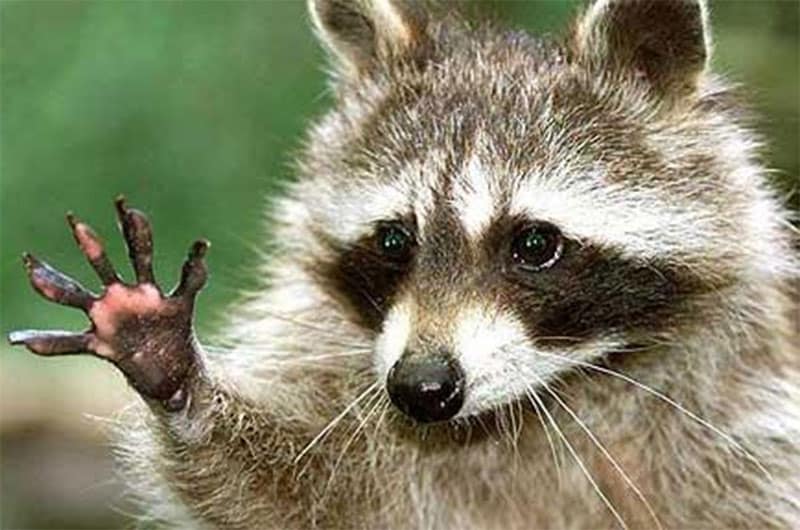by Sarah Treanor Bois, Director of Research & Education for the Linda Loring Nature Foundation
Last week an animal was seen on Nantucket that hadn’t been seen in at least a year. One mention of it on Facebook immediately garnered over 120 likes and comments. People wanted to know every detail , asked for proof, and how they could see it for themselves. Was it an unusual bird? A great white shark? No, those creatures are a dime a dozen. It was our good friend, Rocky the Nantucket Raccoon.
Over two years ago now, June of 2015, a lone raccoon was spotted falling off of a lumber truck as it drove past Hatch’s on Orange Street. Apparently it scampered into the wetlands behind the package store and made its escape from there. For weeks, the town animal control officer and the Environmental Police tried to capture the beast. Sightings were all over Facebook feeds as people tracked our raccoon from town to Miacomet, Quaise, and back again.
It wasn’t long before this raccoon got into the Nantucket spirit and had his own Twitter feed (@ACKraccoon). This went on for a while and then the flurry of activity faded and we were left to wonder about our masked bandit. Was it a he or a she? Did it have enough food and resources to survive? If it did, would it be our only raccoon or would there eventually be more to the population?
Where had it gone? Was it a dumpster diver or had it made its way to the wilds of the Middle Moors? We were left with more questions than answers and lots of rumors. Some people swear there were two raccoons. Others claimed to have one living in their yard. The last semi-official sighting was in August of 2016 near the Nantucket Hotel. Since then there have been multiple rumors of raccoon sightings in the Tom Nevers area. There were also several stories that the raccoon had been found as roadkill on Polpis Rd.
It seems that vulture food was not actually the end for our masked bandit. Rocky is back.
Skyler Kardell, Nantucket High Schooler and avid birder, was up early the morning of August 7 in Siasconset “owling.” This is when intrepid birders go out at dusk or dawn to call for owls. Skylar was out by the water tower looking and listening for owls when he spotted it. “I JUST SAW A RACCOON behind ‘Sconset water tower @ 3:40 a.m.” was his Facebook post to the Nantucket Community. While some claimed it must have been a cat or a large rat, the legend of the Nantucket raccoon has again been given new life.
Apparently, this isn’t the first time raccoons have been to the island. According to Hidden History of Nantucket (by Frank Morral & Barbara Ann White), the last time raccoons were seen on the island was 1858, when a small population at what is now Sanford Farm was eliminated by an organized hunt. However, one raccoon was shot in 1893. It was mounted and displayed on the pharmacy on Main St.
Why should we care?
Nantucket has very few mammals, and people are often surprised to hear that we don’t have on the island some that are common in mainland Massachusetts: there are no skunks, possums, foxes, coyotes, beavers, bears, fishers, nor bobcats on Nantucket. The other species that do call Nantucket home have evolved and thrived in the absence of these predators. A new predator could have devastating effects on a system that has developed in the absence of large mammalian predators. Animals may be “caught off guard” and defenseless in the face of a new threat. Raccoons feed on ground-nesting birds, eggs, amphibians, and fish. They eat acorns, various fruits, and can develop a preferential diet when food is plentiful. As many of us know, they have become accustomed to humans in many areas and can become a trash nuisance. Nantucket has multiple species of ground-nesting birds that thrive on the island in the absence of mammalian predators (other than rats and feral cats). Piping plovers, terns, and oystercatchers are just a few of the shorebirds that have been prey for raccoons on the mainland. Our sandplain grasslands host northern harriers, American woodcock, eastern towhees, and eastern meadowlarks; all ground-nesters which could be prey for hungry raccoons. One raccoon may not seem like too much for an island devoid of predators, but just one hungry raccoon with a preference for bird eggs could have a devastating effect on any of the aforementioned species.
Fortunately, this lone raccoon was likely a male and not likely to have any tag-alongs. According to Raccoons: A Natural History, by Samuel I. Zeveloff, dispersal of raccoons tends to be driven by young males looking for their own territories. These young males often can’t compete for mates with the older males, so they move on to find their own territory. If that’s how our hitchhiker ended up on a logging truck headed for Nantucket, we’ll never know, but one thing is for sure; he may have abundant food resources, but still no mates to be had. While we can’t confirm this latest raccoon sighting, it is just one more record of a potential legend.
Should you see a raccoon out and about, call the Nantucket Police Department at 508-228-1212 or Nantucket Safe Harbor for Animals at 508-825-2287.



